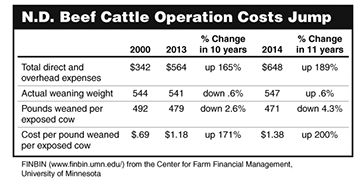
Kris Ringwall
Beef Talk
The cost of beef production is up 200%.
Data show beef production is becoming expensive.
I am not referring to the end product, but rather to the weaned calf. The cost per pound weaned per exposed cow has jumped 200% since the turn of the century. That is not good news.
 Cost control is critical in every business. If costs are allowed to run out of control, the next step is liquidation. The beef business is no different. Producers need to be cautious when operating within affluent prices. Those checks coming in can be very deceiving if not appropriately matched to the checks going out.
Cost control is critical in every business. If costs are allowed to run out of control, the next step is liquidation. The beef business is no different. Producers need to be cautious when operating within affluent prices. Those checks coming in can be very deceiving if not appropriately matched to the checks going out.
Historically, beef producers are not overly enthusiastic recordkeepers. With a fairly constant production phase, producers have kept costs at a minimum. They were willing to maintain when prices were typical and appreciate good prices when they cycled through.
With a tight checkbook and several multigenerational family members keeping their eyes on expenses, things worked fine. Dad was not asked to buy something that was not absolutely needed. Even then, why buy it if some other mechanism could be jerry-rigged to get the job done?
Where are these thoughts coming from? My usual sources are the North Dakota Farm and Ranch Business Management Education Program (www.ndfarmmanagement.com) database and FINBIN (www.finbin.umn.edu/) from the Center for Farm Financial Management, University of Minnesota. Levi Helmuth, farm business management instructor at the Dickinson Research Extension Center, and other North Dakota instructors contribute to the database.
A review of North Dakota numbers from FINBIN since 2000 certainly shows the changes, compared with today. What has changed? The simple answer is that income means nothing without a cost calculation. While many producers generally understand that feed and the cost of maintaining the cow inventory are large, one of the biggest expenses is total direct and overhead costs.
In 2000, producers spent, on average, $342 per cow for total direct and overhead expenses. By 2013, that average value was $564 per cow, an increase of 165%. In 2014, that average value was $648 per cow, an increase of 189%.
Has calf output kept up with expenses? No. In 2000, according to FINBIN, the average weaned calf weight was 544 pounds (lb.). It was 541 lb. in 2013 and 547 lb. in 2014. Pounds weaned per exposed cow was 492 in 2000, 479 in 2013 and 471 in 2014. This amounts to a cost per pound of weaned calf per cow exposed of 69¢ in 2000, $1.18 (up 171%) in 2013 and $1.38 (up 200%) in 2014.
So, what is likely to go up and what is likely to go down? That is the painful question. Historically, costs tend to remain or increase through time. Occasionally, costs, particularly feed costs, will go down as prices fluctuate in the grain and hay market.
Supply and demand drive the market. Direct costs often are called variable costs because they do vary and respond to the current market. Overhead costs are certainly more long term, and a conservative approach to accruing long-term debt always is advisable. Those debt payments, locked in for a fixed number of years, can become problematic if the value drops out of the beef business.
As the beef industry interacts with the market, individual producers must decide their individual approach to survival and to meeting the family and operational goals. Invariably, those thoughts will include dollars. Why be in the beef business without a return to labor and management?
With the current demand for replacement cattle indicative of a positive industry stance to maintaining and expanding the beef business, now is the time to ponder some fundamental costs of the business. The direct costs are manageable, but remember, replacement of breeding stock is leading the pack in regard to negative impact on the gross margin per cow.
Then comes the long-term question: Is there enough revenue to maintain and expand, which means an adequate return on investment on total assets? The real answer to the question of profit rests with the ability to complete a process that fundamentally provides a proper business evaluation.
Why is this important? The dynamics of the beef business change, and yet the beef producer is trying to focus down the road. Increased direct and overhead costs, and retirement or family expansion create difficult questions. For now, buy wisely, spend thriftily and control costs. More later.
May you find all your ear tags.

Editor’s Note: Kris Ringwall is a beef specialist for North Dakota State University Extension. For more information, contact https://www.ag.ndsu.edu/news or North Dakota State University Extension Service, NDSU Dept. 7000, 315 Morrill Hall, P.O. Box 6050, Fargo, ND 58108-6050.
[Click here to go to the top of the page.]





